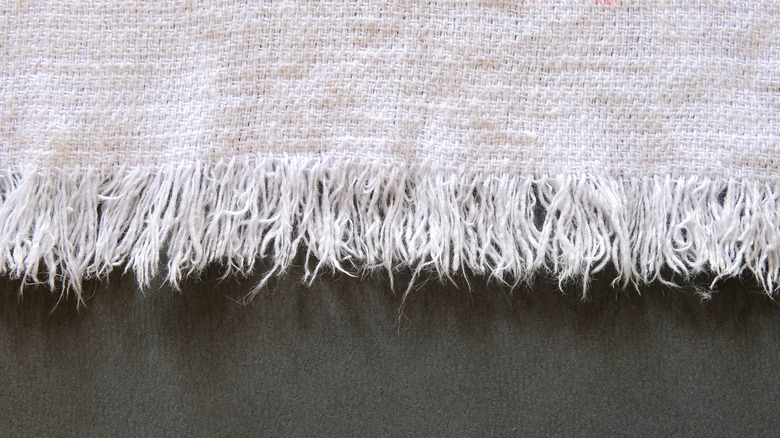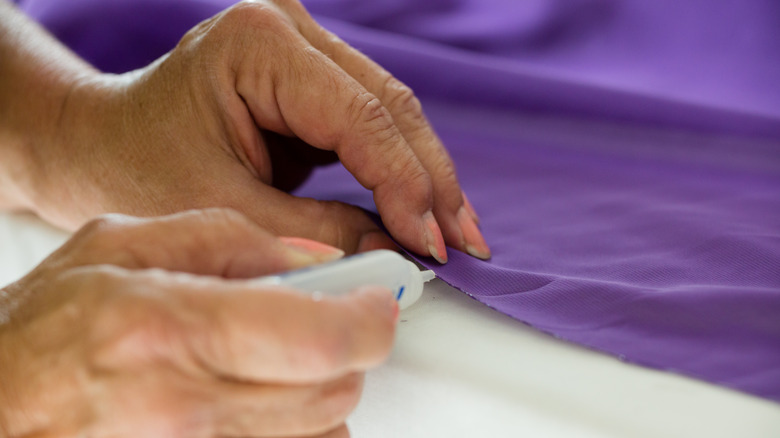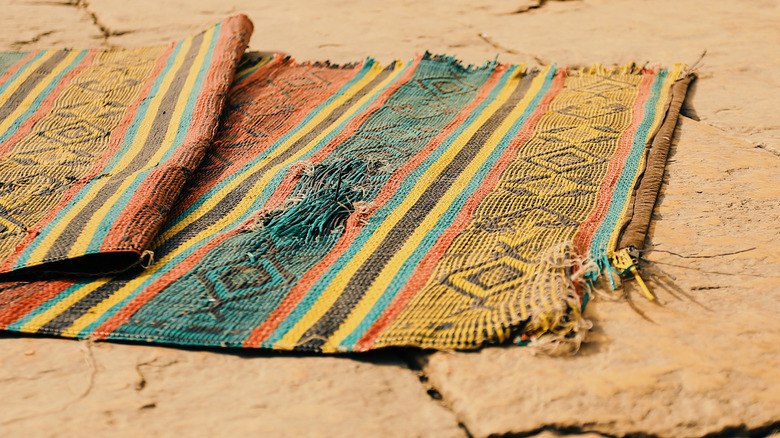The Quick Fix For Fraying Fabric That Doesn't Involve Any Sewing
Your guest bedroom sheets have an unsightly edge, your pets have done a number on your drapes, or your vintage cloth napkins aren't aging so gracefully ... there are a lot of times when you might discover that a cherished fabric item has started to fray. Fraying is caused when fabric has an unfinished edge, also known as a "raw" edge. Normally, this raw edge is folded over and stitched down to close it off, but if the stitching comes undone or the fabric is torn somewhere, raw edges reappear and can begin to unravel. America already generates about 17 million tons of textile waste per year (according to TheRoundUp), so don't discard your favorite sheets just because they have a fray. Repair them instead! Knowing how to sew can come in handy, but how should you fix frays if you don't know how to sew, you're low on sewing supplies, or your sewing machine is temporarily out of commission? Reach for pinking shears, masking tape, or liquid seam sealant.
Perhaps you do already know how to sew, but you haven't been keeping your sewing room organized with the help of a handy pool noodle. In cases like these, there are a few handy methods you should know for stopping those pesky fabric frays in their tracks — and none of them involve a needle and thread. Here's how you can repair frayed material using items you may already own and tips for fixing frays on a wide range of home textiles.
Three quick no-sew fixes
The first solution to stop fraying fabric is to grab a pair of pinking shears, like the Fiskars 9" pinking shears, available for $31.99 at JOANN. Don't worry; pinking shears won't turn your fabric pink. These special scissors are designed to cut a zig-zag shape on the edge of any woven fabric. While pinking shears may not stop fraying completely, they cut on the bias, which slows down the fraying process. Pinking shears are a great solution for finely woven fabrics like cotton sheets or curtain linings, but they should be used in an area that won't easily be spotted. Otherwise, they're great for making an intentionally slightly frayed edge on decorative pieces like table runners.
If you don't want your fabric piece to fray at all, you can opt for a bottle of liquid seam sealant, such as Dritz Fray Check, available in a 2-pack at JOANN for under $6.00. To stop your fray from worsening, trim the loose threads, then carefully apply a thin line of Fray Check along the raw edge and allow it to dry. This is a great method for sheets, tablecloths, napkins, and other fabrics that will be seen and handled. Another quick fix is to apply a strip of Scotch tape to the edge of the fabric, then trim lengthwise down the tape to create a smooth edge. This works temporarily for curtains and tablecloths that won't be seen or handled on the taped side.
Handling heavy-duty fabric frays
Fixing a frayed edge on sheets, curtains, tablecloths, and other finely woven fabrics is relatively easy using one of the simple no-sew methods above. But does this work on more plush, heavy weaves like towels, rugs, upholstery, and burlap décor? Pinking shears won't be a good solution for these heavier materials, as the fine zig-zag edge won't do much to keep these thicker threads from fraying. Liquid seam sealer could help temporarily, but likely won't hold up long-term to frequent washings and rough handling that towels and rugs are subjected to.
It's important to note that liquid seam sealant is not the same as fabric glue. Liquid seam sealer strengthens and binds fine stitching to itself to prevent unraveling. For tough fraying projects like rugs and upholstery, you may need to reach for a more heavy-duty fabric glue. Cut off the loose threads, then brush an even layer of glue over the edge and let it dry before cutting away any leftover threads. You may need to repeat this process occasionally as the glue wears away and the weave starts to fray again. Otherwise, consider bringing your beloved frayed projects to a professional, which also requires no sewing (on your part)! If your items are frayed beyond repair, there are plenty of practical ways to upcycle old towels, repurpose bed sheets, and more.


